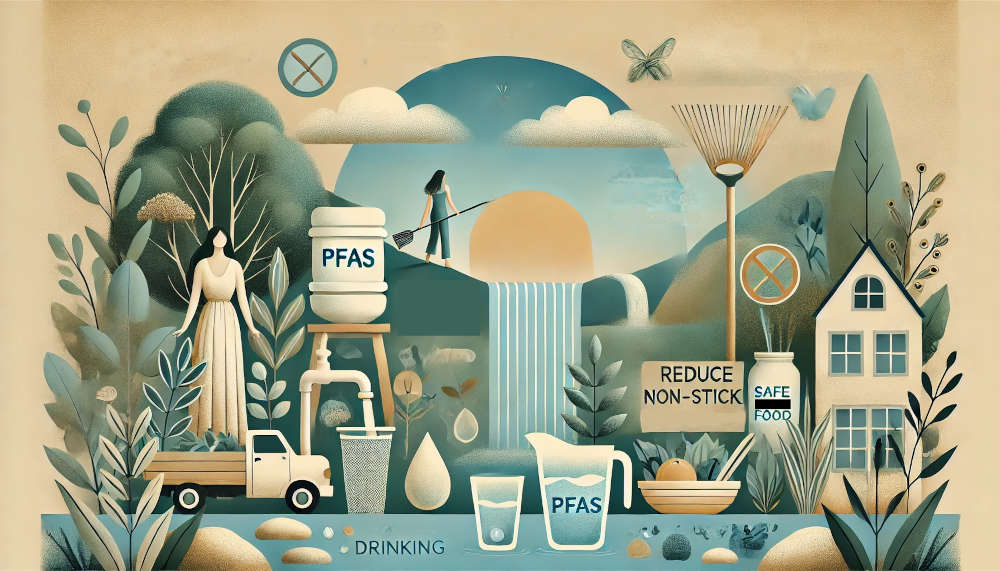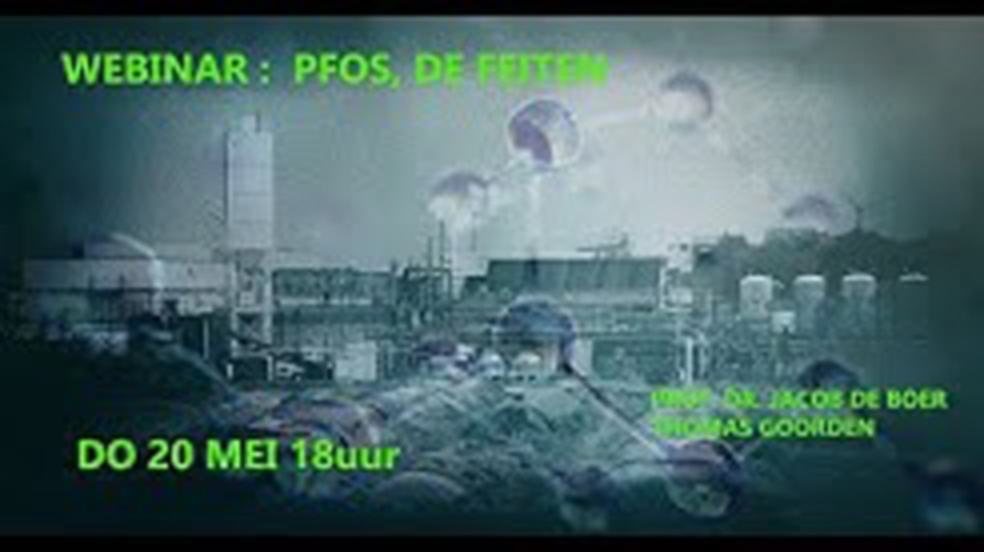PFAS zitten overal, van voedsel tot drinkwater. Ontdek effectieve manieren om blootstelling te beperken en je gezondheid te beschermen tegen deze schadelijke stoffen.
23.02.2025 | Grondrecht
PFAS volledig uit de wereld helpen lijkt een onmogelijke opdracht. Deze chemische stoffen zitten inmiddels overal: in alledaagse producten, voedsel, water, lucht en zelfs in de bodem. Niemand kan eraan ontsnappen. Toch betekent dit niet dat er niets te doen valt om de blootstelling te minimaliseren. Iedere bewuste keuze heeft impact op de gezondheid, zowel voor jezelf als voor toekomstige generaties.
PFAS, oftewel per- en polyfluoralkylstoffen, zijn door mensen vervaardigde chemicaliën die water, vet en vuil afstoten. Ze zijn te vinden in antiaanbaklagen van pannen, waterafstotende kleding, voedselverpakkingen, cosmetica, bakpapier en zelfs in medische toepassingen zoals stents. Hoewel ze functioneel zijn, brengen ze een ernstig milieuprobleem met zich mee. Ze breken nauwelijks af en hopen zich op in het milieu, in dieren en uiteindelijk ook in ons lichaam. Zelfs ijsberen op de Noordpool, ver van elke fabriek, blijken besmet met PFAS. Dit illustreert hoe wijdverspreid deze stoffen zijn.
In Europa wordt gewerkt aan een breed PFAS-verbod, wat hoop biedt. Ondertussen zijn alle PFAS opgenomen op de lijst van Zeer Zorgwekkende Stoffen (ZZS), waardoor bedrijven verplicht zijn de uitstoot ervan te verminderen en alternatieven te zoeken. Overheden en burgers strijden tegen de chemische industrie, maar de realiteit blijft dat PFAS al alomtegenwoordig zijn. Waar opruimen niet mogelijk is, moeten we leren omgaan met de risico’s. Bovendien zijn deze chemicaliën nog steeds aanwezig in producten die we dagelijks gebruiken.
PFAS komen op twee manieren in het milieu en in ons lichaam terecht. Enerzijds gebeurt dit via industriële uitstoot van fabrieken zoals Chemours in Dordrecht, waarbij deze stoffen in lucht, water en bodem terechtkomen. De hoogste concentraties bevinden zich in de directe omgeving, maar verspreiding via lucht- en waterstromen zorgt ervoor dat PFAS ook elders terechtkomen. Anderzijds komen ze vrij via consumentenproducten. Wanneer deze producten worden weggegooid en verbrand, wordt de PFAS-structuur slechts gedeeltelijk afgebroken. De impact van deze zogenaamde korteketenvormen van PFAS is nog onvoldoende onderzocht, al lijkt de schadelijkheid ervan minder groot te zijn dan die van de langeketenvormen.
Ondanks de onvermijdelijke aanwezigheid van PFAS zijn er manieren om de blootstelling te beperken en de vraag naar deze schadelijke stoffen terug te dringen. Bewust consumeren speelt een cruciale rol. Het kiezen voor PFAS-vrije producten vermindert uiteindelijk de productie en helpt zo de vervuiling bij de bron aan te pakken. De blootstelling via consumentenproducten blijft doorgaans beperkt, zolang deze correct worden gebruikt. Bij producten zoals antiaanbakpannen en regenkleding is het belangrijk om beschadiging te vermijden, zodat PFAS niet vrijkomen. Andere producten, zoals verf, blusschuim en ski-wax, bevatten PFAS die sneller in de omgeving terechtkomen. Gebruik deze bij voorkeur buiten of in een goed geventileerde ruimte.
Voeding vormt een belangrijke bron van PFAS-inname. Nederlanders krijgen gemiddeld driemaal meer PFAS binnen via voedsel dan via drinkwater. Vooral vis en visproducten bevatten hoge concentraties, terwijl groenten en fruit doorgaans minder PFAS bevatten. De exacte hoeveelheid hangt af van de herkomst van het voedsel, aangezien bodem- en watervervuiling grote variaties veroorzaken. Gevarieerd eten helpt om de blootstelling te spreiden en de risico’s te verkleinen.
Afvalverwerking speelt een sleutelrol bij het beperken van PFAS-verspreiding. Door PFAS-houdende producten op de juiste manier weg te gooien, zoals oude pannen naar de milieustraat brengen en plastic correct sorteren, blijft de milieu-impact beperkt. Regelmatig stofzuigen helpt om PFAS uit huis te verwijderen, aangezien deze stoffen zich ophopen in stofdeeltjes. Een wekelijkse schoonmaakbeurt vermindert de blootstelling binnenshuis aanzienlijk.
Voor consumenten die willen nagaan welke producten PFAS bevatten, biedt de website Waarzitwatin.nl waardevolle informatie. Fabrikanten zijn bovendien verplicht om binnen 45 dagen informatie te verstrekken over de aanwezigheid van deze stoffen in hun producten. Wie twijfelt over de veiligheid van kraanwater kan gerust zijn. Nederlands drinkwater voldoet aan de Europese normen en blijft essentieel voor een gezonde levensstijl. Flessenwater is mogelijk een alternatief, maar daarover ontbreekt nog voldoende wetenschappelijk onderzoek. Bovendien zorgt het transport en de verpakking van flessenwater voor extra milieubelasting.
Borstvoeding blijft een belangrijk onderwerp in de discussie over PFAS. Hoewel deze stoffen via moedermelk aan baby’s worden doorgegeven, wegen de voordelen van borstvoeding zwaarder. Het biedt bescherming tegen infecties en ziekten zoals diabetes en vermindert de kans op allergieën. Voor ouders die hun kinderen willen beschermen tegen PFAS gelden dezelfde aanbevelingen: bewust consumeren, gevarieerd eten, correct afval verwerken en regelmatige schoonmaak in huis. Extra richtlijnen voor moestuinen, zwemplassen en kippeneieren zijn beschikbaar voor bewoners in sterk vervuilde regio’s, zoals rondom de Chemours-fabriek in Dordrecht.
De strijd tegen PFAS vraagt om collectieve actie en bewustwording. Hoewel het volledig uitbannen van deze chemicaliën tijd kost, kan elke consument bijdragen door slimme keuzes te maken. Bewust omgaan met producten, voeding en afval zorgt ervoor dat de blootstelling aan PFAS beperkt blijft. Met de juiste maatregelen blijft de impact op de gezondheid en het milieu beheersbaar, terwijl wetgeving en innovatie hopelijk leiden tot een duurzame oplossing voor dit wereldwijde probleem.
Bron:
https://www.ad.nl/dordrecht/hoe-kan-ik-blootstelling-aan-pfas-verminderen~a3e0578c



